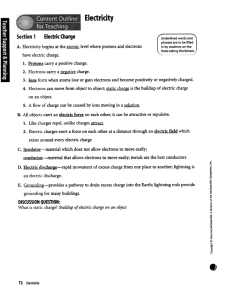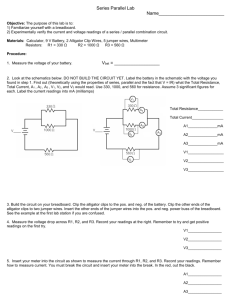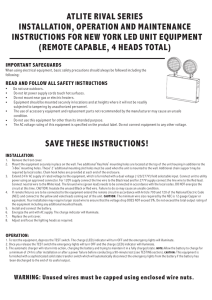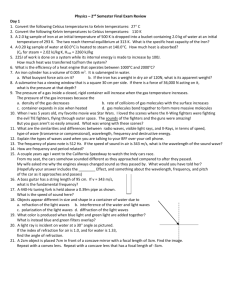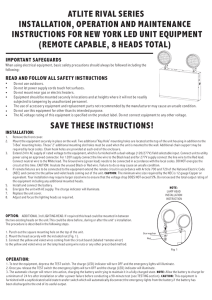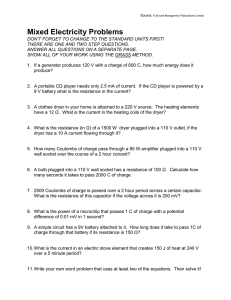17 Direct Current Circuits
advertisement
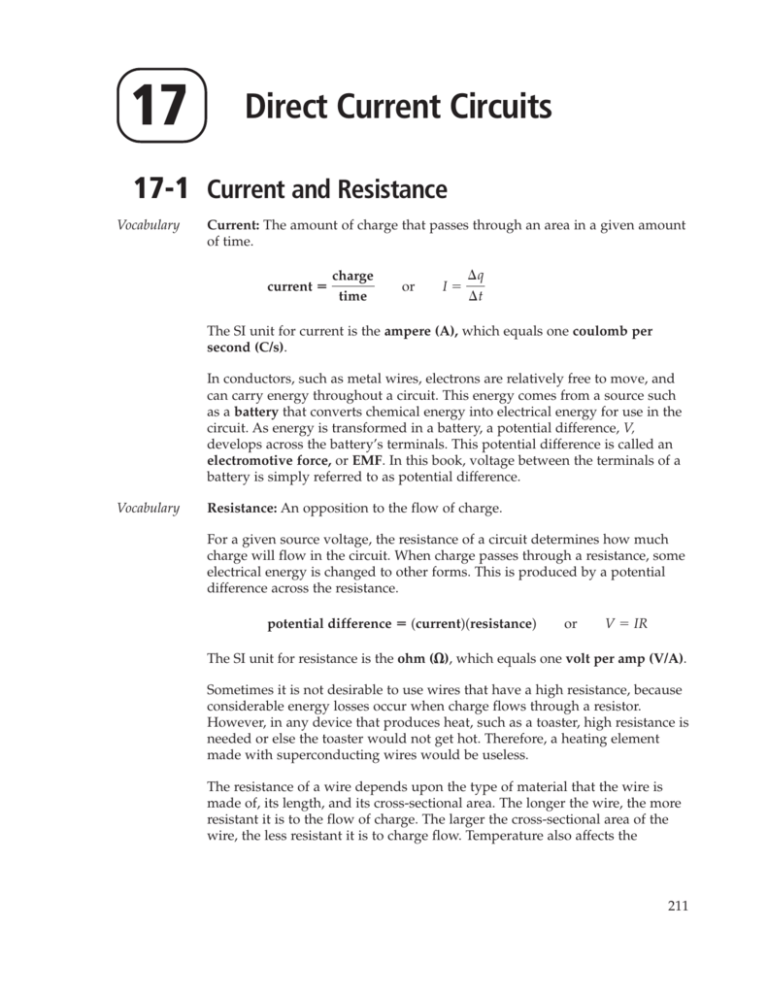
17 Direct Current Circuits 17-1 Current and Resistance Vocabulary Current: The amount of charge that passes through an area in a given amount of time. current charge time or I ¢q ¢t The SI unit for current is the ampere (A), which equals one coulomb per second (C/s). In conductors, such as metal wires, electrons are relatively free to move, and can carry energy throughout a circuit. This energy comes from a source such as a battery that converts chemical energy into electrical energy for use in the circuit. As energy is transformed in a battery, a potential difference, V, develops across the battery’s terminals. This potential difference is called an electromotive force, or EMF. In this book, voltage between the terminals of a battery is simply referred to as potential difference. Vocabulary Resistance: An opposition to the flow of charge. For a given source voltage, the resistance of a circuit determines how much charge will flow in the circuit. When charge passes through a resistance, some electrical energy is changed to other forms. This is produced by a potential difference across the resistance. potential difference (current)(resistance) or V IR The SI unit for resistance is the ohm (), which equals one volt per amp (V/A). Sometimes it is not desirable to use wires that have a high resistance, because considerable energy losses occur when charge flows through a resistor. However, in any device that produces heat, such as a toaster, high resistance is needed or else the toaster would not get hot. Therefore, a heating element made with superconducting wires would be useless. The resistance of a wire depends upon the type of material that the wire is made of, its length, and its cross-sectional area. The longer the wire, the more resistant it is to the flow of charge. The larger the cross-sectional area of the wire, the less resistant it is to charge flow. Temperature also affects the 211 resistance of a wire. The hotter the wire, the more resistant it becomes to the flow of charge. This means that more current will flow through a toaster when it is first turned on than when the coils are glowing red hot. Solved Examples Example 1: Household current in a circuit cannot generally exceed 15 A for safety reasons. What is the maximum amount of charge that could flow through this circuit in a house during the course of a 24.0-h day? Solution: Because the unit ampere means coulombs per second, 24.0 h must be converted in 86,400 s. Given: I 15 A t 86,400 s Unknown: q ? ¢q Original equation: I ¢t Solve: q It (15 A)(86,400 s) 1.3 106 C Example 2: What is the resistance of the heating element in a car lock de-icer that contains a 1.5-V battery supplying a current of 0.5 A to the circuit? Given: V 1.5 V I 0.5 A Solve: R Unknown: R ? Original equation: V IR V 1.5 V 3 I 0.5 A Practice Exercises Exercise 1: Arthur is going trick-or-treating for Halloween so he puts new batteries in his flashlight before leaving the house. Until the batteries die, it draws 0.500 A of current, allowing a total of 5400. C of charge to flow through the circuit. How long will Arthur be able to use the flashlight before the batteries’ energy is depleted? t q/I (5400. C)/(0.500 A) 10,800 s Answer: 212 Direct Current Circuits 10,800 s Exercise 2: Fabian’s car radio will run from the 12-V car battery that produces a current of 0.20 A even when the car is turned off. The car battery will no longer operate when it has lost 1.2 106 J of energy. If Fabian gets out of the car and leaves the radio on by mistake, how long will it take for the car battery to go completely dead (that is, lose all energy)? q W/V (1.2 106 J)/(12 V) 1.0 105 C t q/I (1.0 105 C)/(0.20 A) 5.0 105 s or 139 h Answer: Exercise 3: 139 h While cooking dinner, Dinah’s oven uses a 220.-V line and draws 8.00 A of current when heated to its maximum temperature. What is the resistance of the oven when it is fully heated? R V/I (220. V)/(8.00 A) 27.5 Answer: Exercise 4: 27.5 Justine’s hair dryer has a resistance of 9.00 when first turned on. a) How much current does the hair dryer draw from the 110.-V line in Justine’s house? b) What happens to the resistance of the hair dryer as it runs for a long time? a) I V/R (110. V)/(9.00 ) 12.2 A b) The resistance goes up. Exercise 5: Answer: a. 12.2 A Answer: b. increases Camille takes her pocket calculator out of her bookbag as she gets ready to do her physics homework. In the calculator, a 0.160-C charge encounters 19.0 of resistance every 2.00 seconds. What is the potential difference of the battery? I q/t (0.160 C)/(2.00 s) 0.0800 A V IR (0.0800 A)(19.0 ) 1.52 V Answer: 1.52 V Direct Current Circuits 213




